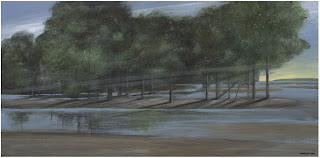Highly Productive Polar Forests from the Permian of Antarctica
Authors:
Miller et al
Abstract:
Two stratigraphically closely spaced bedding planes exposed at Lamping Peak in the Upper Buckley Formation, Beardmore Glacier area, Antarctica contain abundant in situ stumps (n=53, n=21) and other plant fossils that allow reconstruction of forest structure and biomass of Glossopteris forests that thrived at ~ 75o S paleolatitude in the Permian. Mean trunk diameter is 14 and 25 cm, corresponding to estimated mean maximum heights of 12 and 19 m. Basal areas are 65 and 80 m2ha- 1. The above ground biomass was calculated using allometric equations for Ginkgo biloba, yielding biomasses of 147 and 178 Mg ha- 1. Biomass estimates based on comparison with biomass of modern forests with equivalent basal areas are higher (225 – 400 Mg ha- 1). The amount of above ground biomass added each year (Annual Net Primary Productivity), based on biomass estimates and growth rings in silicified plant material from the Buckley Formation nearby, is poorly constrained, ranging from ~ 100 – 2000 g m- 2 yr- 1.
Compared to modern forests at all latitudes, the Permian forests have high basal areas and high biomass, exceeded in both only by forests of the U.S. Pacific northwest and Sequoia forests. The estimated range of productivity (ANPP) is within that of many very productive modern forests. The Lamping Peak forests’ basal areas and calculated biomass are also larger than younger high paleolatitude fossil forests except for Arctic Cenozoic forests.
Presence of these highly productive fossil forests at high paleolatitude is consistent with hothouse conditions during the Late Permian, prior to the eruption of the Siberian flood basalts.
Friday, June 26, 2015
Highly Productive Polar Forests in Permian Antarctica Before Siberian Traps Eruptions
Labels:
antarctica,
forests,
fossils,
late permian,
paleobotany,
paleoclimate,
paleoenvironment,
paleozoic,
Permian,
polar forests
Subscribe to:
Post Comments (Atom)

No comments:
Post a Comment